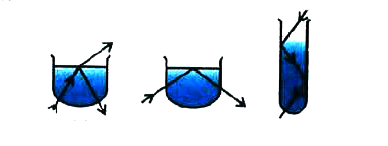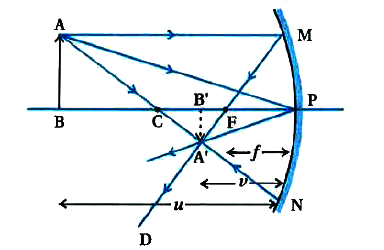Explain experiment which represents the total internal reflection. Solution in Gujrati
Take a glass beaker with clear water in it. Stir the water a few times with a piece of soap, so that it becomes a little turbid.
Take a laser pointer and shine its beam through the turbid water. You will find that the path of the beam inside the water shines brightly.

Shine the beam from below the beaker such that it strikes at the upper water surface at the other end it undergoes partial reflection which is seen as a spot on the table below and partial refraction which comes out in the air and is seen as a spot on the roof figure (a).
Now direct the laser beam from one side of the beaker such that it strikes the upper surface of water more obliquely figure (b). Adjust the direction of laser beam until you find the angle for which the refraction above the water surface is totally absent and the beam is totally reflected back to water. This is total internal reflection at its simplest.
Pour this water in a long test tube and shine the laser light from top as shown in figure (C). Adjust the direction of the laser beam such that it is totally internally reflected every time it strikes the walls of the tube. This is similar to what happens in optical fibres.
Note: Take care not to look into the laser beam directly and not to point it at anybody.s face.
Topper's Solved these Questions
- RAY OPTICS AND OPTICAL INSTRUMENTSBook:KUMAR PRAKASHANChapter:RAY OPTICS AND OPTICAL INSTRUMENTSExercise:SECTION - A (TRY YOURSELF)
Explore 74 Videos
- RAY OPTICS AND OPTICAL INSTRUMENTSBook:KUMAR PRAKASHANChapter:RAY OPTICS AND OPTICAL INSTRUMENTSExercise:SECTION-B (NUMERICALS)(NUMERICAL FROM TEXTUAL ILLUSTRATIONS)
Explore 17 Videos
- MOVING CHARGES AND MAGNETISMBook:KUMAR PRAKASHANChapter:MOVING CHARGES AND MAGNETISMExercise:SECTION D (MCQs ASKED IN COMPETITIVE EXAMS)
Explore 34 Videos
- SAMPLE QUESTION PAPER Book:KUMAR PRAKASHANChapter:SAMPLE QUESTION PAPER Exercise:PART-B SECTION-C
Explore 5 Videos
Similar Questions
Give range of wavelength of visible light.
View SolutionSuppose that the lower half of the concave mirror.s reflecting surface as shown in figure is covered with an opaque (non-reflective) material. What effect will this have on the image of an object placed in front of the mirror ?

View SolutionElectric charge Q having mass M moves on a circular path of radius R with velocity →v, perpendicular to uniform magnetic field B. When a particle completes one revolution, work done by the field is _______
View SolutionTwo charges –q and +q are located at points (0, 0, –a) and (0, 0, a), respectively.
(a) What is the electrostatic potential at the points (0, 0, z) and (x, y, 0) ?
(b) Obtain the dependence of potential on the distance r of a point from the origin when r/a>>1 .
(c) How much work is done in moving a small test charge from the point (5,0,0) to (–7,0,0) along the x-axis? Does the answer change if the path of the test charge between the same points is not along the x-axis?
View SolutionWith a neat labelled diagram, explain the terms total internal reflection and critical angle.
View SolutionPartial reflection and Total internal reflection.
View SolutionExplain the phenomenon of total internal reflection.
View SolutionWhat is total internal reflection of light ? What are conditions for total internal reflection ?
View SolutionExplain briefly how the phenomenon of total internal reflection is used in fibre optics.
View SolutionExplain internal reflection and total internal reflection.
View SolutionExplain the phenomena of total internal reflection in right angle prism.
View SolutionExplain Total internal reflection
OR
Under what conditionsistotal internal reflection possible? Explain it with a suitable example.
Define critical angle of incidence and obtain an expression for it.
View SolutionWhat are the technological applications of total internal reflection in nature ? Briefly explain it.
View SolutionFor a total intemal reflection, which of the following is correct?
View SolutionExplain total internal reflection from law of refraction.
View Solution

